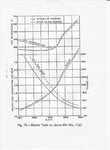drgondog
Major
Extrapolated further, if Mcr for the Me-262 was only .8M in a dive, it was within the envelope of a pursuing Mustang - and that would not be 'insignificant'.
The Spitfire was said to have had an Mcr of 0.89, the Tempest 0.83, the Mustang 0.8, the Meteor 0.83 and the Schwalbe 0.86. Any advantage to the Schwalbe over the Meteor would be at least partly due to the higher aspect ratio of the wing, surely. And that advantage is bought at the expense of lower wing second moment of area and hence structural strength, a tradeoff which only makes sense for a specialist interceptor.
Regards,
Magnon
The Spit Mcr probably was lower than .89 as the speed it attained during the documented dive trials was well into Mcr. The max speed recorded for a Mustang dive (that returned intact) was .84-.85 and there were visible signs of structural damage. I don't know about the Tempest. My comment above was to illustrate that a couple of percentage points delay in Mcr would be significant - not that the 262 was limited (ultimate limit) to .8
As to 'advantages' one way or the other, one needs a full set of data to make valid statements regarding structural integrity, static margin limits, total Cg travel, trim drag at extreme AoA, etc.
When you pose that 'any advantage to the Schwalbe over the Meteor would be partly due to the AR of the wing, surely" - what are you thinking about specifically?
AR would have an effect on Induced drag, but by itself leaves much to be discovered relative to structural considerations. The wing design on the 262 would be influenced by three primary factors - L/D obviously, Structural integrity, and low speed stability. The leading edge slats would have been added to improve manueverability at high AoA as well as add to the low speed handling characteristics. I am not overlooking fuel capacity or the aero interference drag brough about by the nacelles but those would have been in the trade offs while trying to maximize the mission specs.
The sweep, as noted in the historical accounts was designed to move the aerodynamic center at the MAC aft to improve the stability throughout the cg range. It should have, despite repeated opinions, also influenced the drag rise favorably by a couple of percentage points, particularly with later models that sewpt from the root to the tip, rather that straight leading edge from root to engine.
The planform taper/tip would be further refinement to minimize induced drag for that airfoil and also structural considerations
Far more importantly is the root chord geometry and the taper to the wing tip. The depth of the spar at the root and the main beam/torque box geometry will have much to say about both stresses due to the lift distribution effect on bending loads and the tosion applied by aerodynamic loads and vortex which must be distributed spanwise to the root.
Mc/I is of course a classic equation for stress on a homogeneous body due to a bending load - but in airframe design back in those days a 'normal' spar design was top and lower caps (usually extrusions), augmented by wing skin to take out the axial loads resulting from bending and a shear panel to transfer the axial loads from one cap to the other...what did you have in mind with the 'lower wing second moment of area and hence lower strength"??
I can get all the 'strength' one needs to take out bending in say a 9% t/c by either lengthening the chord (Spitfire approach) to deepen the spar (local 'thickness') for a beam cap/shear panel design of certain area and web shear panel thickness, or maintain 9% with shorter chord (Me 262) by a variety of ways but all would increase wing weight. (i.e. increase cap area, same cap area/thicker surface skin)

